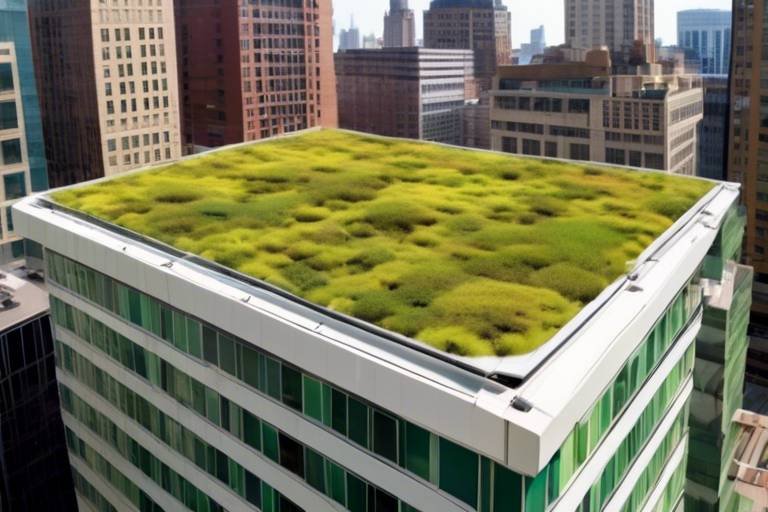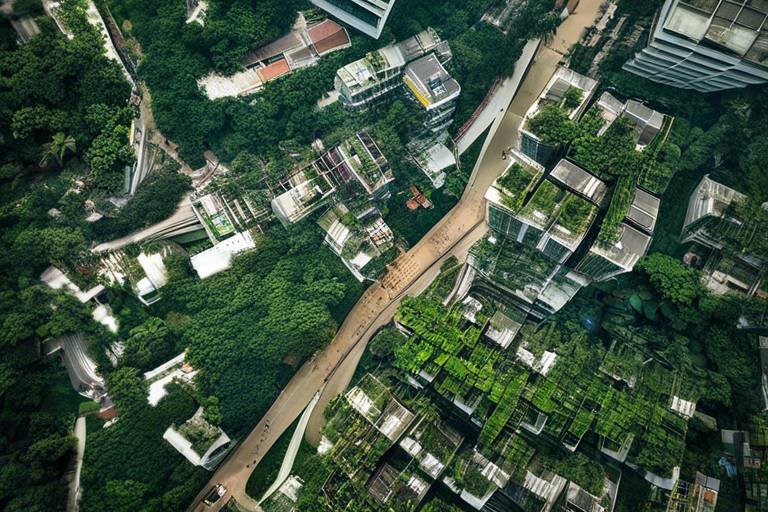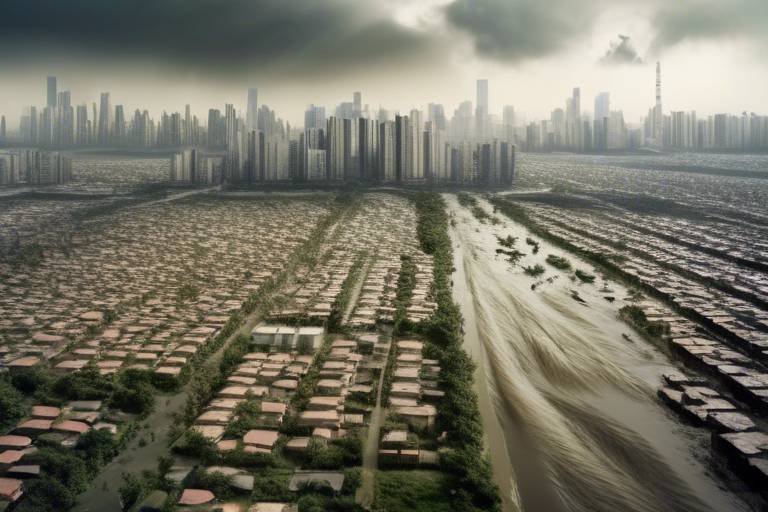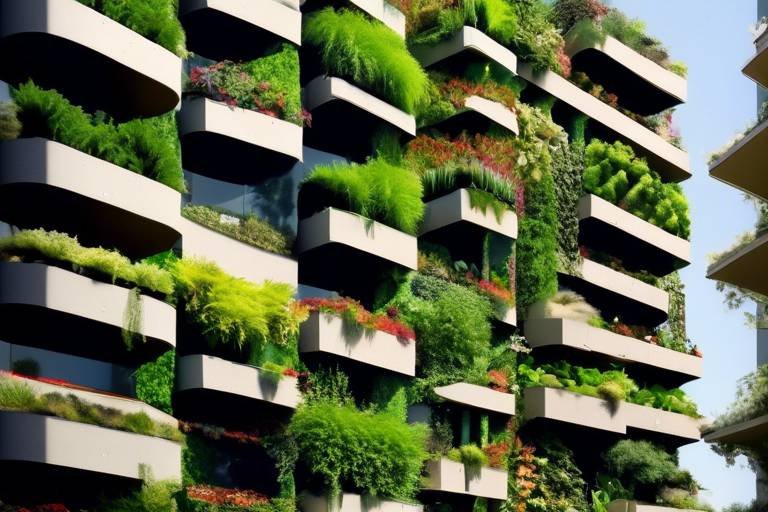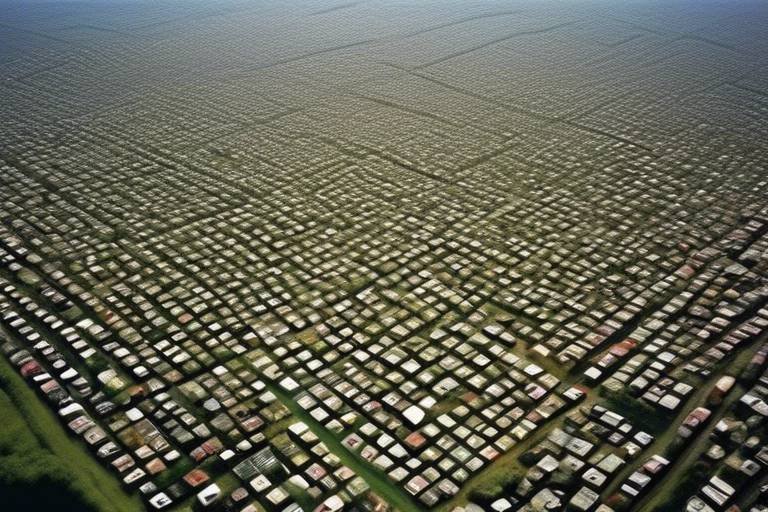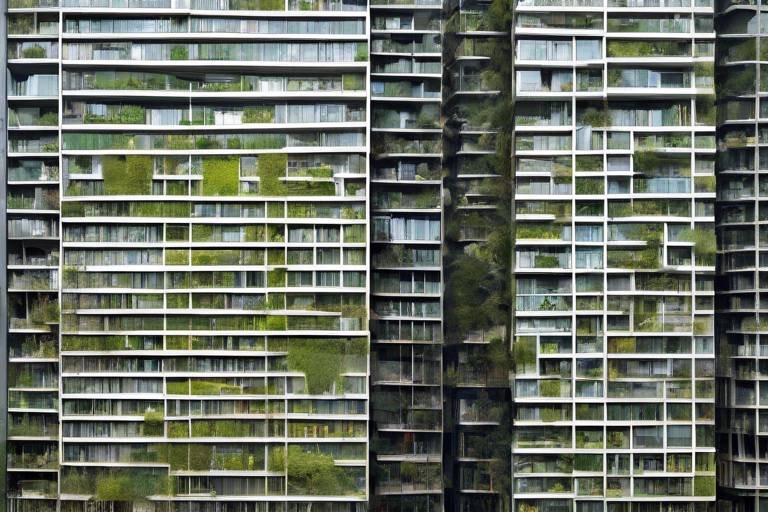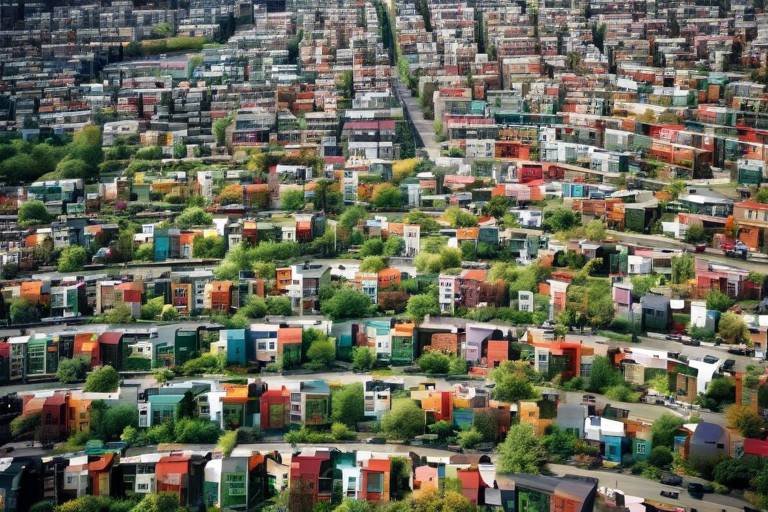Exploring the Impact of Green Spaces in Urban Environment
Imagine stepping out of your concrete jungle and into a lush, vibrant park filled with trees, flowers, and chirping birds. It's a refreshing escape, isn't it? Green spaces in urban environments are more than just pretty patches of land; they are vital lifelines that contribute to the ecological, social, and health fabric of city life. In this article, we will dive deep into the significance of these green havens, exploring their multifaceted benefits and the challenges we face in nurturing them.
Urban green spaces play a crucial role in enhancing biodiversity, improving air quality, and regulating temperatures. They act as the lungs of our cities, filtering pollutants and providing oxygen. Think about it: every tree you see is not just a beautiful sight; it's a powerhouse of ecological benefits. These areas contribute to ecological balance in city environments by:
- Enhancing Biodiversity: Green spaces provide habitats for various species, from birds to insects, fostering a rich ecosystem even in bustling cities.
- Improving Air Quality: Trees absorb carbon dioxide and release oxygen, significantly reducing air pollution levels.
- Regulating Temperatures: Urban heat islands can be alleviated by the cooling effects of trees and vegetation, making cities more livable.
In essence, urban green spaces are not just aesthetically pleasing; they are essential for maintaining ecological health in our cities.
Have you ever noticed how parks and gardens become the heart of a community? They are more than just places to relax; they are vibrant gathering spots where friendships are forged and communities come alive. Green spaces foster social interactions and enhance community cohesion by providing a platform for people to connect. Whether it's a weekend picnic, a yoga class, or simply a stroll with a friend, these spaces encourage social engagement.
Access to green spaces has been linked to improved mental health outcomes. Research shows that spending time in nature can alleviate stress, reduce anxiety, and boost overall well-being. Just think about how a simple walk in the park can lift your spirits. Studies indicate that individuals who regularly engage with nature report higher levels of happiness and lower instances of depression.
Now, let’s talk about therapeutic landscapes. These are specifically designed green spaces aimed at enhancing healing and relaxation. Imagine a garden that not only looks beautiful but is also designed to soothe the mind and spirit. Such spaces can be particularly beneficial for individuals facing mental health challenges, offering a serene environment that promotes recovery and peace.
Urban life can be stressful, but nature-based solutions offer effective ways to mitigate these stressors. By incorporating green spaces, cities can tackle issues like noise pollution and urban heat. For example, a well-placed park can absorb sound, making the surrounding area quieter and more peaceful. Furthermore, greenery can help cool down hot city streets, making them more comfortable for residents.
Investing in green spaces can yield significant economic benefits. Parks not only enhance the aesthetic value of neighborhoods but also increase property values and attract tourism. A well-maintained park can become a local attraction, drawing visitors and boosting local businesses. In fact, studies have shown that homes near parks often sell for higher prices compared to those further away. It’s a win-win situation: beautiful green spaces enhance community life while also providing economic returns.
Despite their myriad benefits, creating and maintaining green spaces presents challenges. Issues such as funding, land availability, and community engagement can hinder the development of these vital areas. Urbanization often conflicts with green space preservation, leading to a tug-of-war between development and sustainability.
Finding a balance between urban development and green space preservation is crucial. Cities must strategize to ensure that as they grow, they also maintain areas for nature. Innovative planning and community involvement can help create sustainable green areas amidst urban sprawl.
Engaging communities in the planning process is essential for successful green space development. When residents have a say in designing and maintaining their local parks, they are more likely to take ownership and care for these spaces. Methods such as workshops, surveys, and community meetings can help gather input and foster a sense of belonging.
Q: What are the main benefits of urban green spaces?
A: Urban green spaces enhance biodiversity, improve air quality, provide mental health benefits, and offer economic advantages.
Q: How do green spaces affect property values?
A: Properties near parks and green spaces typically have higher values due to increased desirability and aesthetic appeal.
Q: What challenges do cities face in maintaining green spaces?
A: Challenges include funding limitations, land availability, and ensuring community engagement in the planning process.
Q: How can communities get involved in green space planning?
A: Communities can participate through workshops, surveys, and meetings to voice their needs and preferences for local parks.

The Ecological Benefits of Urban Green Spaces
Urban green spaces are not just aesthetically pleasing; they are vital to the ecological health of cities. Imagine a bustling metropolis where the air is filled with the sounds of honking cars and bustling crowds. Now, picture a lush park amidst that chaos, providing a breath of fresh air—literally! These green areas play a crucial role in enhancing biodiversity, improving air quality, and regulating temperatures.
Firstly, let's talk about biodiversity. Urban green spaces serve as habitats for various species, from birds to insects, that might otherwise struggle to survive in concrete jungles. They act as ecological corridors, allowing wildlife to thrive in urban settings. For instance, a single park can host numerous species of flora and fauna, creating a mini-ecosystem that supports life. This biodiversity is essential for maintaining ecological balance, as it helps in pollination and pest control.
Next up, air quality! Have you ever noticed how you feel a bit lighter after spending time in a park? That's not just in your head. Trees and plants in urban areas absorb carbon dioxide and release oxygen, significantly improving the air we breathe. According to studies, urban greenery can reduce air pollution levels by up to 30%. This is particularly important in cities where air quality can often be compromised by traffic and industrial emissions.
Another fascinating aspect of green spaces is their ability to regulate temperatures. Urban areas tend to create "heat islands," where temperatures can be significantly higher than surrounding rural areas. Green spaces help mitigate this effect by providing shade and releasing moisture into the air through a process called transpiration. A well-placed park can lower local temperatures by several degrees, making the urban environment more comfortable for its residents.
| Benefit | Impact |
|---|---|
| Biodiversity Enhancement | Supports various species and ecological balance |
| Air Quality Improvement | Reduces pollution and increases oxygen levels |
| Temperature Regulation | Mitigates urban heat island effect |
However, the benefits of urban green spaces extend beyond the immediate ecological impact. They also contribute to the overall health of urban residents. Studies have shown that people living near parks and green areas tend to have lower rates of respiratory issues and other health problems. The simple act of spending time in nature can reduce stress and encourage physical activity, leading to healthier lifestyles.
In conclusion, urban green spaces are not merely patches of grass and trees; they are essential components of our cities that provide ecological benefits that are hard to overlook. From improving air quality to supporting biodiversity and regulating temperatures, these areas are vital for creating sustainable urban environments. As cities continue to grow, the importance of integrating green spaces into urban planning cannot be overstated.
- Why are urban green spaces important? They improve air quality, enhance biodiversity, and provide recreational areas for residents.
- How do green spaces affect mental health? Access to nature has been linked to reduced stress and improved overall well-being.
- Can urban green spaces help with climate change? Yes, they can mitigate heat effects and improve air quality, contributing to climate resilience.

Social Interaction and Community Well-being
Green spaces are more than just patches of grass or clusters of trees in our bustling urban environments; they are the lifeblood of community interaction and well-being. Imagine stepping into a park where laughter fills the air, children are playing, and neighbors are chatting over a picnic. This vibrant scene is a testament to how parks and gardens serve as essential gathering places that foster social interactions and strengthen the bonds among residents. In a world where technology often isolates us, these natural havens remind us of the importance of face-to-face connections.
Research has shown that access to green spaces can significantly enhance our quality of life. They provide a venue for various activities that bring people together, such as community events, sports, and cultural festivals. These activities not only entertain but also promote a sense of belonging and community pride. When residents come together in green spaces, they share experiences that create lasting memories. Just think of it as a melting pot where diverse backgrounds blend, fostering understanding and acceptance among neighbors.
Moreover, green spaces encourage physical activity, which is crucial for overall health. When people gather in parks, they are more likely to engage in walking, jogging, or playing sports, all of which contribute to physical fitness. This increase in physical activity can lead to improved mental health, as exercise is known to release endorphins—the body's natural mood lifters. In essence, parks can be viewed as community gyms that promote both physical and mental well-being.
Another significant aspect of green spaces is their role in enhancing community cohesion. They serve as neutral grounds where individuals from different walks of life can come together. This shared space can lead to the formation of friendships and networks that might not have developed otherwise. In fact, many community initiatives, such as neighborhood watch programs or local clean-up events, often originate in these parks, demonstrating how they can spark collective action and collaboration.
To illustrate the impact of green spaces on social interaction, consider the following table that summarizes key benefits:
| Benefit | Description |
|---|---|
| Enhanced Social Ties | Green spaces provide a venue for residents to meet and interact, fostering friendships and community networks. |
| Physical Activity | Parks encourage exercise, which can lead to improved physical and mental health outcomes. |
| Cultural Events | Green spaces often host community events that celebrate local culture and diversity, strengthening community identity. |
| Community Initiatives | They serve as the starting point for collaborative efforts, such as clean-up drives and neighborhood safety programs. |
In conclusion, the role of green spaces in urban settings extends far beyond aesthetics. They are vital for social interaction and community well-being, acting as catalysts for connection, collaboration, and a healthier lifestyle. As urban planners and communities continue to recognize these benefits, the push for more accessible and well-designed green spaces will only grow stronger. After all, a community that plays together, stays together, and what better place to do that than in the heart of nature?
- What are the main benefits of urban green spaces?
Urban green spaces provide ecological benefits, enhance social interactions, improve mental health, and can boost local economies.
- How do green spaces affect mental health?
Access to green spaces has been linked to reduced stress, anxiety, and depression, promoting overall mental well-being.
- Can green spaces increase property values?
Yes, properties located near well-maintained parks often see an increase in value due to their desirability.
- What challenges do cities face in creating green spaces?
Challenges include funding limitations, land availability, and ensuring community engagement in the planning process.

The Role of Parks in Mental Health
When was the last time you took a stroll through a park and felt a wave of calm wash over you? It’s no coincidence that parks have a profound impact on our mental health. Research has shown that spending time in green spaces can significantly reduce stress levels and improve overall well-being. Imagine parks as natural therapy sessions, where the rustling leaves and chirping birds serve as soothing background music to our thoughts. Studies indicate that just a brief encounter with nature can enhance mood and alleviate feelings of anxiety.
But why does this happen? One reason is that parks provide a break from the hustle and bustle of urban life. They offer a sanctuary where one can escape the noise and chaos, allowing for moments of reflection and peace. Furthermore, engaging with nature has been linked to lower cortisol levels, the hormone associated with stress. When you immerse yourself in a park, you're not just enjoying the scenery; you're actively participating in a process that can enhance mental clarity and emotional resilience.
Additionally, parks often serve as social hubs, where individuals can connect with others. This social interaction is crucial for mental health. When people gather in these green spaces, they share experiences, laughter, and support, which can create a sense of belonging. Think of parks as the heart of a community, pumping social energy and connection throughout the neighborhood. A study published in the journal Environmental Science & Technology revealed that individuals living near parks reported higher levels of happiness and lower levels of depression.
Moreover, parks can be designed with specific features that enhance their therapeutic benefits. For instance, incorporating walking trails, meditation gardens, and sensory experiences can cater to various mental health needs. Such therapeutic landscapes are becoming increasingly popular, as they not only provide a place for leisure but also foster healing and relaxation. Imagine a space where you can walk barefoot on soft grass, listen to the gentle flow of water from a nearby fountain, and breathe in the fresh air—this is what therapeutic landscapes aim to create.
In addition to direct benefits, parks also play a role in addressing urban stressors. For example, they can mitigate the effects of noise pollution and urban heat, both of which can contribute to mental strain. The presence of trees and vegetation can act as natural sound barriers, creating a serene environment that promotes relaxation. By integrating green spaces into urban planning, cities can not only improve the physical environment but also enhance the mental well-being of their residents.
In conclusion, the role of parks in mental health is undeniably significant. They are not just patches of greenery; they are vital components of our urban ecosystems that offer numerous psychological benefits. As we continue to recognize the importance of mental health, it becomes essential to advocate for the preservation and development of these green spaces. After all, investing in parks is investing in the mental health of our communities.
- How do parks improve mental health? Parks provide a calming environment, reduce stress, and foster social connections, all of which contribute to improved mental health.
- Can spending time in parks help with anxiety? Yes, research shows that exposure to nature can lower anxiety levels and promote feelings of relaxation.
- What features make parks therapeutic? Features like walking trails, meditation gardens, and water elements can enhance the therapeutic benefits of parks.
- How can communities support the development of green spaces? Community involvement in planning and maintaining parks is crucial. Residents can advocate for green spaces and participate in local initiatives to enhance these areas.

Therapeutic Landscapes
The concept of is more than just a trendy buzzword; it's a profound acknowledgment of how our surroundings can impact our mental and emotional well-being. Imagine stepping into a space where nature embraces you, where the rustling leaves and chirping birds create a symphony that soothes your soul. These landscapes are meticulously designed to promote healing and relaxation, offering a sanctuary from the chaos of urban life. The power of nature is undeniable, and therapeutic landscapes harness this power to create environments that foster recovery and rejuvenation.
Research has shown that spending time in green spaces can significantly reduce stress, anxiety, and even symptoms of depression. In fact, a study published in the journal Environmental Science & Technology found that just five minutes of exercise in a natural environment can enhance mood and self-esteem. This is where therapeutic landscapes come into play, as they are often designed with specific features that encourage interaction with nature. Elements such as water features, native plants, and shaded seating areas can transform an ordinary park into a healing oasis.
One of the key components of therapeutic landscapes is their accessibility. They are not just for those who are already feeling well; they are designed to be inclusive, welcoming everyone from children playing to elderly individuals seeking solace. By incorporating universal design principles, these spaces ensure that all community members can benefit from the healing properties of nature. For example, wide, paved paths allow for easy navigation for people with mobility challenges, while sensory gardens engage individuals with cognitive impairments through touch, smell, and sight.
Moreover, the integration of art into therapeutic landscapes can further enhance their impact. Sculptures, murals, and interactive installations can evoke emotions and spark creativity, providing an additional layer of therapeutic benefit. The combination of nature and art creates a holistic environment that nurtures the mind and spirit, encouraging visitors to linger longer and engage more deeply with their surroundings.
As urban planners and landscape architects continue to recognize the importance of mental health, the design of therapeutic landscapes is evolving. Here are some key elements that are often incorporated:
- Natural Elements: Water features, trees, and native plants that promote biodiversity and provide a calming atmosphere.
- Social Spaces: Areas designed for gatherings, encouraging community interaction and support.
- Quiet Zones: Secluded spots for reflection and solitude, allowing individuals to recharge.
- Interactive Features: Elements that engage the senses, such as fragrant flowers and textured pathways.
In conclusion, therapeutic landscapes serve as vital components in the urban environment, offering a refuge where individuals can find peace and healing amidst the hustle and bustle of city life. By prioritizing the design of these spaces, we not only enhance the quality of life for residents but also contribute to a healthier, more vibrant community.
- What are therapeutic landscapes? Therapeutic landscapes are designed environments that promote mental health and well-being through interaction with nature.
- How do therapeutic landscapes benefit mental health? They provide a calming atmosphere that can reduce stress, anxiety, and depression, encouraging relaxation and recovery.
- What features are common in therapeutic landscapes? Common features include water elements, native plants, social spaces, quiet zones, and interactive installations.
- Can anyone use therapeutic landscapes? Yes, therapeutic landscapes are designed to be inclusive and accessible to all community members, regardless of age or ability.

Nature-Based Solutions for Urban Stress
In today's fast-paced urban environments, stress is an omnipresent challenge that affects the well-being of city dwellers. However, nature-based solutions offer a refreshing antidote to this pervasive issue. Imagine stepping into a park after a long day; the rustling leaves, chirping birds, and vibrant greenery create an instant sense of calm. These natural elements not only beautify our surroundings but also play a pivotal role in stress reduction. By integrating green spaces into urban planning, cities can significantly mitigate the adverse effects of urban stressors.
Research has shown that exposure to nature can lower cortisol levels, the hormone associated with stress. A study conducted by the University of Queensland found that individuals who spent time in green spaces reported lower stress levels and improved mood. This is not just anecdotal; it's backed by science! The soothing effects of nature can be likened to a balm for the urban soul, providing a necessary respite from the hustle and bustle of city life.
Moreover, nature-based solutions extend beyond mere aesthetics; they encompass various strategies that utilize the natural environment to address urban challenges. For instance, incorporating green roofs and walls can help reduce urban heat, while also improving air quality. These solutions serve multiple purposes: they cool buildings, filter pollutants, and create habitats for urban wildlife. The benefits are extensive, as illustrated in the table below:
| Nature-Based Solution | Benefits |
|---|---|
| Green Roofs | Reduces heat, improves air quality, provides insulation |
| Urban Forests | Enhances biodiversity, absorbs CO2, provides shade |
| Rain Gardens | Manages stormwater, filters pollutants, supports wildlife |
| Community Gardens | Promotes social interaction, encourages local food production, enhances mental well-being |
Furthermore, creating spaces that encourage community engagement can amplify these benefits. Think about community gardens where neighbors come together to cultivate plants. These gardens not only provide fresh produce but also foster a sense of belonging and community spirit. When people connect with nature and each other, they often experience a profound reduction in stress levels. It's a win-win situation!
Lastly, the integration of nature in urban design is not merely about creating green spaces; it's about rethinking how we interact with our environment. Urban planners are increasingly recognizing the importance of designing cities that prioritize nature. This shift in perspective reflects a growing understanding that healthy ecosystems contribute to healthy communities. As we move forward, embracing nature-based solutions can pave the way for more resilient and vibrant urban landscapes.
- What are nature-based solutions? Nature-based solutions refer to strategies that use natural processes and ecosystems to address urban challenges, such as stress and pollution.
- How do green spaces reduce stress? Green spaces provide a calming environment that lowers cortisol levels and enhances mood, leading to improved mental health.
- Can urban forests improve air quality? Yes, urban forests absorb pollutants and provide oxygen, contributing to better air quality in cities.
- What role do community gardens play in urban areas? Community gardens promote social interaction, increase access to fresh produce, and enhance community well-being.

Economic Advantages of Urban Greenery
When we think about urban greenery, we often picture parks filled with children playing, joggers enjoying their morning runs, and families having picnics on sunny afternoons. But beyond these delightful scenes lies a powerful economic engine that urban green spaces provide. Investing in green areas can lead to significant financial benefits for cities and their residents. It's not just about aesthetics; it's about increased property values, attracting tourism, and even reducing municipal costs.
One of the most immediate economic advantages of urban greenery is the impact on real estate. Properties located near parks and gardens often see a noticeable increase in value. According to various studies, homes near green spaces can sell for up to 20% more than those further away. This can be attributed to the desirability of living near nature, which enhances the overall quality of life. Buyers are often willing to pay a premium for the tranquility and beauty that green spaces provide. This phenomenon can be summarized as follows:
| Proximity to Green Space | Potential Increase in Property Value |
|---|---|
| Within 0.5 miles | Up to 20% |
| Within 1 mile | 10% - 15% |
| More than 1 mile | Minimal impact |
Moreover, urban green spaces can act as a magnet for tourism. Cities that prioritize parks and natural areas often see an influx of visitors who are eager to experience the beauty of nature amidst the urban landscape. This tourism can lead to increased revenue for local businesses, including restaurants, hotels, and shops. Think about it: when tourists flock to a city for its beautiful parks, they spend money in the local economy, creating jobs and boosting economic growth.
Additionally, green spaces can help cities save money in the long run. For instance, well-placed trees can significantly reduce heating and cooling costs by providing shade in the summer and windbreaks in the winter. According to some estimates, a single tree can save a homeowner around $100 annually in energy costs. When scaled up across a city, these savings can amount to millions of dollars. Furthermore, urban greenery can also reduce stormwater management costs by improving drainage and reducing the risk of flooding.
In essence, the economic advantages of urban greenery are multifaceted. They not only elevate property values and attract tourism but also contribute to long-term savings for cities. The integration of parks and green spaces into urban planning is not just a luxury; it’s a necessity for sustainable development. So, as cities continue to grow and evolve, prioritizing green spaces will be crucial for fostering both economic prosperity and community well-being.
- What are the primary economic benefits of urban green spaces?
The primary economic benefits include increased property values, attraction of tourism, and reduced municipal costs related to energy and stormwater management.
- How do green spaces affect property values?
Properties located near parks and gardens often sell for significantly more than those that are further away, with potential increases of up to 20%.
- Can urban greenery help reduce city expenses?
Yes, urban greenery can lead to savings in energy costs and lower stormwater management expenses, contributing to overall municipal budget efficiency.
- Are there any studies supporting these economic claims?
Yes, various studies have documented the positive impacts of urban green spaces on property values and local economies.

Challenges in Urban Green Space Development
Creating and maintaining urban green spaces is no walk in the park. Despite their undeniable benefits, the journey toward developing these precious oases is often riddled with challenges. One of the most significant hurdles is **funding**. Municipal budgets are frequently stretched thin, and allocating funds for parks and green spaces can be a tough sell when competing against pressing needs like housing, transportation, and education. This financial constraint can lead to poorly maintained parks or, worse yet, the absence of green spaces altogether.
Another challenge is the **availability of land**. As cities expand and populations grow, land becomes a hot commodity. Developers often see green spaces as prime real estate that could be transformed into commercial or residential projects. This creates a tug-of-war between the need for urban development and the desire to preserve green areas. In many cases, it feels like a game of chess, where every move must be calculated to ensure that green spaces don’t get sacrificed on the altar of urbanization.
Moreover, **community engagement** plays a pivotal role in the success of urban green spaces. Without the active involvement of residents, these areas can fail to meet the needs of the community. It’s not enough to simply throw a few benches and trees into the mix; parks must be designed with input from those who will use them. This means organizing meetings, gathering feedback, and truly listening to the voices of the community. When residents feel a sense of ownership, they are more likely to care for and maintain these spaces.
To illustrate these challenges, consider the following table that outlines some common obstacles faced in urban green space development:
| Challenge | Description |
|---|---|
| Funding | Limited budgets often prioritize other urban needs over green space development. |
| Land Availability | Urbanization leads to competition for land, making it difficult to preserve green areas. |
| Community Engagement | Lack of resident involvement can result in parks that do not meet community needs. |
In addition to these challenges, there’s also the issue of **sustainability**. As climate change continues to impact urban areas, maintaining green spaces in a way that is environmentally friendly becomes crucial. This includes using native plants that require less water, ensuring proper drainage to prevent flooding, and incorporating sustainable practices in the maintenance of these areas. It's a balancing act that requires foresight and planning, much like trying to juggle while riding a unicycle—one misstep, and everything could come crashing down.
Ultimately, addressing these challenges requires a **collaborative effort** among city planners, community members, and environmental advocates. By working together, they can create green spaces that are not only beautiful but also functional and sustainable. So, the next time you stroll through a park, take a moment to appreciate the hard work that goes into creating these vital urban sanctuaries. They are more than just patches of grass; they are the result of a delicate dance between nature and urban development.
- What are the main benefits of urban green spaces? Urban green spaces provide ecological benefits, enhance community well-being, and improve mental health.
- How can communities get involved in green space development? Communities can participate by attending planning meetings, providing feedback, and volunteering for maintenance activities.
- What are some examples of successful urban green spaces? Examples include Central Park in New York City, Millennium Park in Chicago, and the High Line in Manhattan.
- How do green spaces affect property values? Proximity to parks and green spaces often increases property values, making neighborhoods more desirable.
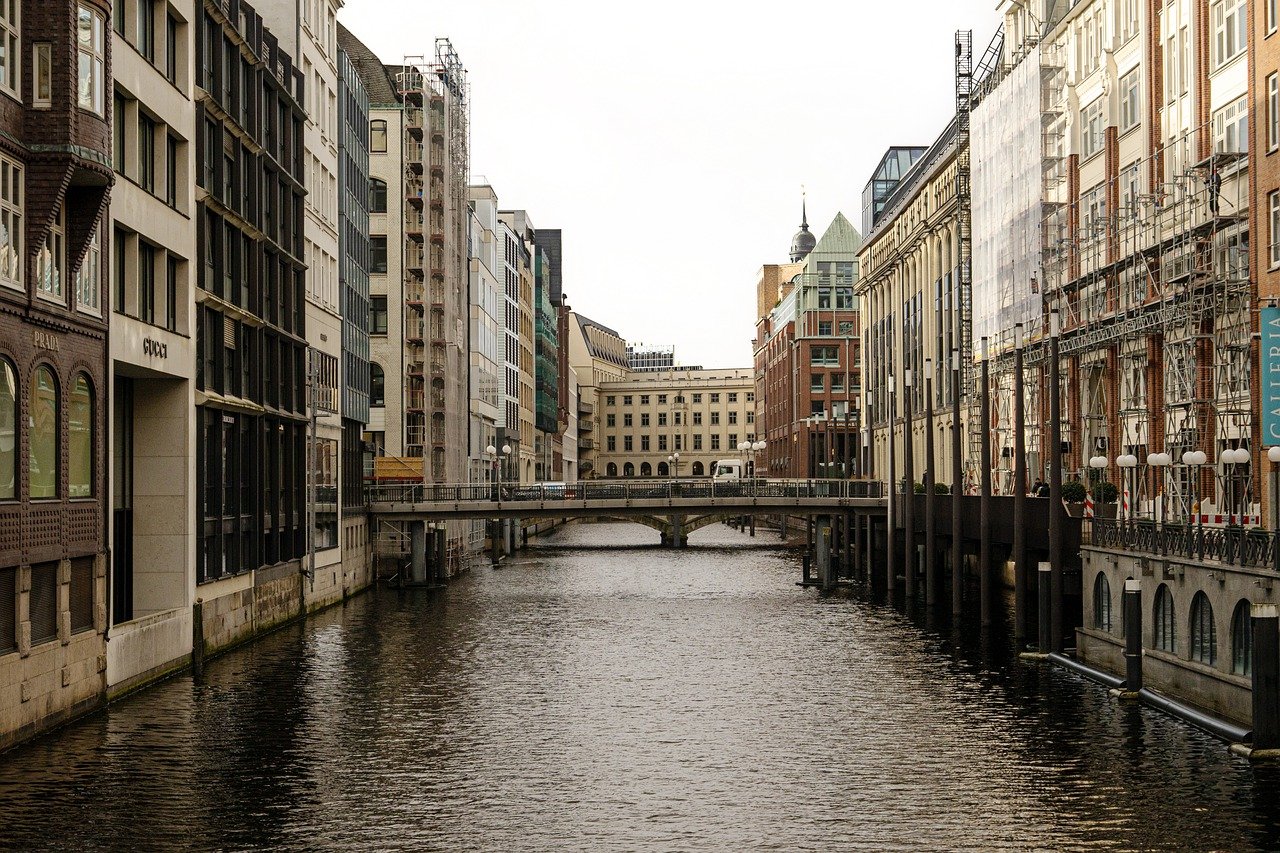
Balancing Development and Green Space
As cities continue to expand at an unprecedented rate, the challenge of balancing development with the preservation of green spaces becomes increasingly critical. Urbanization often leads to the rapid consumption of land, with developers eager to build new residential and commercial properties. However, this pursuit of progress shouldn't come at the expense of our vital green areas. Just like a well-tended garden, a city thrives when it incorporates both modern infrastructure and lush, green landscapes.
One of the most effective strategies for achieving this balance is through integrated urban planning. This approach involves collaborating with city planners, architects, and environmentalists to create a cohesive vision that includes green spaces as essential elements of urban development. For instance, parks can be designed not just as recreational areas but as multifunctional spaces that also serve as stormwater management systems, thus addressing environmental concerns while providing community benefits.
Moreover, incorporating green roofs and vertical gardens into building designs can be a game-changer. These innovations not only beautify the urban landscape but also improve air quality and reduce heat, offering a win-win solution for both developers and the community. Imagine walking down a bustling city street, surrounded by towering skyscrapers, yet being greeted by vibrant greenery cascading down the sides of buildings. It's a visual reminder that development and nature can coexist harmoniously.
However, the reality is that community involvement is crucial in this balancing act. Engaging local residents in discussions about new developments can lead to innovative ideas that prioritize green spaces. For example, public forums can be organized where community members can voice their desires for parks, gardens, and recreational areas. When people feel they have a stake in the development of their neighborhoods, they are more likely to support projects that integrate green spaces.
Additionally, cities can adopt policies that mandate a certain percentage of land in new developments be allocated for green space. This could include everything from small pocket parks to larger community gardens. By setting these requirements, municipalities can ensure that as they grow, they do not lose their vital green lungs. The table below illustrates how different cities have successfully implemented such policies:
| City | Green Space Allocation Policy | Impact |
|---|---|---|
| Singapore | Minimum 10% green space in all new developments | Increased biodiversity and improved air quality |
| Portland | Green space requirement for residential zoning | Enhanced community engagement and property values |
| Barcelona | Green corridors connecting parks | Improved accessibility and recreational opportunities |
In conclusion, balancing development with green spaces is not just a necessity; it's an opportunity to create vibrant, sustainable urban environments. By prioritizing integrated planning, community involvement, and innovative design, cities can ensure that as they grow, they do so in a way that respects and enhances their natural surroundings. After all, a city that embraces its green spaces is a city that thrives.
- Why are green spaces important in urban areas? Green spaces improve air quality, enhance biodiversity, and provide recreational opportunities for residents.
- How can communities get involved in green space planning? Communities can participate through public forums, surveys, and by collaborating with local government on development projects.
- What are some examples of successful green space integration? Cities like Singapore and Portland have implemented policies that require green space in new developments, resulting in numerous ecological and social benefits.
- What role do parks play in mental health? Access to parks and green spaces has been linked to reduced stress levels and improved overall mental well-being.

Community Involvement in Green Space Planning
Community involvement in green space planning is not just a nice-to-have; it’s a game-changer. When residents are actively engaged in the design and upkeep of their local parks and gardens, the result is a space that truly reflects the needs and desires of the community. Imagine walking into a park that feels like an extension of your home—where the flowers bloom in your favorite colors and the play areas cater to your children’s interests. This is the magic of community-driven planning!
One of the most effective ways to ensure that green spaces meet community needs is through collaborative design workshops. These workshops can bring together residents, local government officials, and landscape architects to brainstorm ideas and share visions. The outcome? A park that not only enhances the environment but also serves as a vital social hub. Research shows that when people feel a sense of ownership over a space, they are more likely to take care of it. It’s like the difference between borrowing a book and owning it; the latter comes with a sense of responsibility and pride.
Moreover, community involvement can lead to innovative solutions for common challenges. For instance, in areas where land is scarce, residents might propose vertical gardens or rooftop parks, maximizing the use of available space. This type of thinking can transform even the most constrained urban areas into vibrant green spaces. Here’s a quick look at some popular methods for involving the community:
- Surveys and Questionnaires: Gathering input through surveys allows residents to voice their preferences and concerns.
- Public Meetings: Hosting open forums where community members can discuss ideas fosters transparency and collaboration.
- Volunteer Days: Organizing events where residents can help plant trees or maintain gardens builds a sense of community and ownership.
In addition to these methods, leveraging social media platforms can be a powerful tool for engagement. By creating dedicated pages or groups, communities can share updates, gather feedback, and even organize events. It’s like having a virtual town hall meeting that’s always open! Plus, with the younger generation being more tech-savvy, this approach can attract a diverse range of voices to the conversation.
However, it’s essential to recognize that not all communities are the same. Different neighborhoods have unique cultural, social, and economic dynamics that influence their approach to green space planning. Therefore, it’s crucial to tailor engagement strategies to fit the community’s specific context. For example, in areas with a high percentage of non-English speakers, providing materials in multiple languages can ensure everyone has a voice in the process.
Ultimately, community involvement in green space planning leads to more than just beautiful parks; it cultivates a sense of belonging and pride among residents. When people see their ideas reflected in the spaces they frequent, it fosters a deeper connection to their environment. So, the next time you stroll through a park, take a moment to appreciate the hard work and collaboration that went into its creation. It’s not just a green space; it’s a community masterpiece!
Q1: Why is community involvement important in green space planning?
A1: Community involvement ensures that green spaces meet the actual needs and preferences of the residents, leading to better maintenance and a stronger sense of ownership.
Q2: What methods can be used to engage the community?
A2: Methods include surveys, public meetings, volunteer days, and utilizing social media platforms to gather feedback and organize events.
Q3: How does community involvement affect the maintenance of green spaces?
A3: When residents are involved in the planning and upkeep, they are more likely to take pride in the space, leading to better maintenance and care.
Q4: Can community involvement lead to innovative green space solutions?
A4: Absolutely! Engaging diverse voices can result in creative ideas, such as vertical gardens or multi-use spaces that cater to various needs.
Frequently Asked Questions
- What are the ecological benefits of urban green spaces?
Urban green spaces are vital for enhancing biodiversity, improving air quality, and regulating temperatures. They act as natural filters, absorbing pollutants and providing habitats for various species. By integrating these green areas into city designs, we can help maintain ecological balance and promote healthier urban environments.
- How do green spaces contribute to community well-being?
Green spaces serve as essential gathering places for residents, fostering social interactions and enhancing community cohesion. Parks and gardens provide a venue for families and friends to connect, which strengthens social ties and builds a sense of belonging among community members.
- Can access to green spaces improve mental health?
Absolutely! Research indicates that access to nature can significantly alleviate stress and promote overall well-being. Spending time in green spaces allows individuals to recharge and find peace, making it a natural remedy for mental health challenges.
- What are therapeutic landscapes?
Therapeutic landscapes are specifically designed green spaces that aim to enhance healing and relaxation. These areas incorporate elements like soothing water features, calming plants, and quiet zones, which can be particularly beneficial for individuals facing mental health challenges.
- How do nature-based solutions address urban stress?
Nature-based solutions, such as incorporating green spaces in urban planning, effectively mitigate issues like noise pollution and urban heat. By introducing elements like trees and parks, cities can create cooler, quieter environments that improve the quality of life for residents.
- What economic advantages do urban green spaces offer?
Investing in urban greenery can lead to significant economic benefits, including increased property values and enhanced tourism. Parks and green spaces attract visitors, which can boost local businesses and stimulate economic growth in the area.
- What challenges are faced in developing urban green spaces?
Creating and maintaining urban green spaces can be challenging due to funding constraints, limited land availability, and the need for community engagement. These challenges require innovative solutions to ensure that green spaces can thrive in urban settings.
- How can we balance urban development with green space preservation?
Balancing urban development and green space preservation involves strategic planning that prioritizes sustainability. This can include creating policies that protect existing green areas while integrating new green spaces into urban designs, ensuring that both growth and nature can coexist.
- Why is community involvement important in green space planning?
Engaging communities in the planning process is crucial for the success of green spaces. When residents have a say in the design and maintenance of their local parks, they are more likely to use and care for these areas, leading to vibrant and well-loved community spaces.





